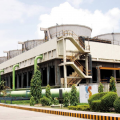Indoor growers love growing with LEDs. These tiny Light Emitting Diodes come with so many advantages when growing greens and fresh plants indoors. When you can grow your favorite herbs, vegetables, plants, and flowers all year round without the need of the natural sunlight, why would you choose anything else? The advancement in LEDs has enabled growers to profit from the fresh and the healthiest food all year round with just a one-time investment.
Out of the many advantages LEDs offer, one outstanding factor is the “Heat Thermal Control”. You can set up a huge indoor growing place with the best lighting system, but with “abundance of right amount of light” you will not achieve success. When you take things inside, out of the sun’s reach, you have to ensure the indoor plants receive all the nutrient supplies for growth. A single factor missing from the chain of conditions required for growth will result in failure.
The right amount of light, temperature control, water, nutrients, hydroponics or soil, and moisture are the key components for growing plants indoors. If all the factors are controlled and managed perfectly but your plants get more heat than required-they will wither off and get burned. Light must be palced at specific height in relation to the plant canopy to avoid burning and damaging plants. Furthermore, grow light fixtures have to be set at a specific angle for growing well.
One of the main advantages of LED grow lights is their lack of excess heat. The lights give off some heat, but very little compared to traditional indoor growing lights. Energy is not wasted as heat and the light can be placed closer to the plants without risk of damaging them. If you are new to indoor gardening here is a summary of some important points about the advantages of LED grow lights:
How Do Grow Lights Work?
Grow lights function by providing your plants with selective wavelengths of the sunlight. They try optimizing their output spectrum by concentrating on PAR wavelengths. (PAR: Photosynthetically active Regions). The wavelengths generated by grow lights boost chemical processes which in return stimulate the growth and flowering of plants. The blue light at the end of the spectrum supports the vegetative process while the red activates the flowering process.
How Do LED Grow Light Control Heat?
A large number of grow lights are available in market with different prices and features. Those that are less expensive have a higher operating cost with low efficiency of producing PAR and wavelengths. They not only contain toxic chemicals, require cooling systems, power supplies and ballasts, but also emit a large heat signature, which makes controlling grow room temperatures difficult.
LED Grow lights stand out because of this heat control feature. They have no filaments and along with efficiency and energy control they can outperform other grow light options. LED grow lights produce minimal to no heat and can be placed extremely close to the plant and also have the power of directing the light exactly where it’s needed.
Where does this heat come from? The heat emitted by LEDs originates from the semiconductors p-n junctions when it’s slight being inefficient and not converting the electrical activity into light. The soldering points in return get heated further heating MCPCB. The metal core printed circuit board has to be directed into heat sink for dissipating into the atmosphere.
The best LED grow lights such as G8LED Grow Lights use heat sinks for controlling heat. Heat sink medium offers a path for LEDs to dissipate the heat into the air. G8LED grow lights also have a passive cooling system that speed heat sink process. The entire process of LED Thermal management is a critical component of LED grow lights and G8LED lighting utilized high performance components for perfect temperature maintenance.



























